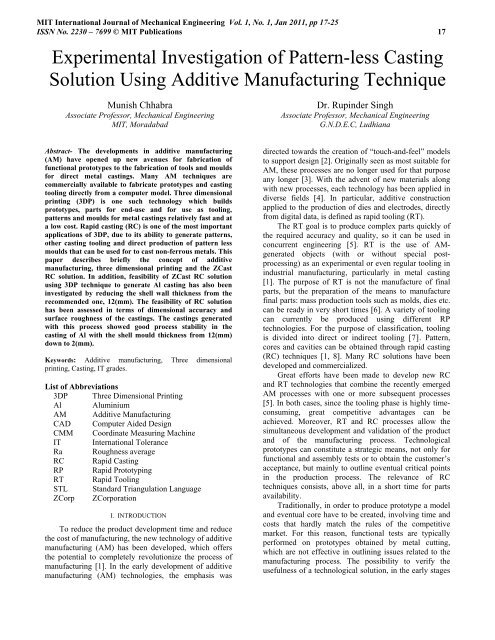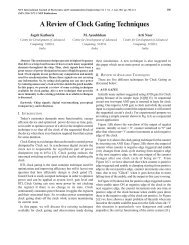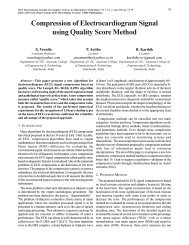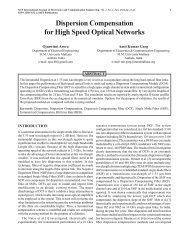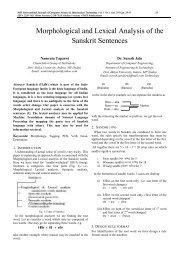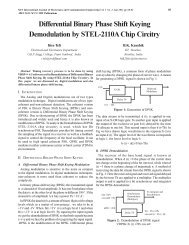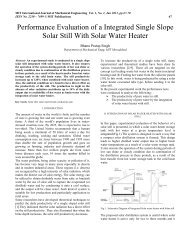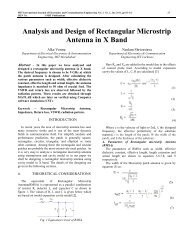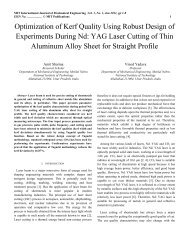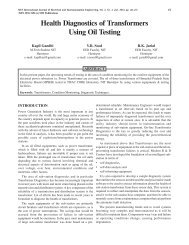Experimental Investigation of Pattern-less Casting ... - MIT Publications
Experimental Investigation of Pattern-less Casting ... - MIT Publications
Experimental Investigation of Pattern-less Casting ... - MIT Publications
Create successful ePaper yourself
Turn your PDF publications into a flip-book with our unique Google optimized e-Paper software.
<strong>MIT</strong> International Journal <strong>of</strong> Mechanical Engineering Vol. 1, No. 1, Jan 2011, pp 17-25ISSN No. 2230 – 7699 © <strong>MIT</strong> <strong>Publications</strong> 17<strong>Experimental</strong> <strong>Investigation</strong> <strong>of</strong> <strong>Pattern</strong>-<strong>less</strong> <strong>Casting</strong>Solution Using Additive Manufacturing TechniqueMunish ChhabraAssociate Pr<strong>of</strong>essor, Mechanical Engineering<strong>MIT</strong>, MoradabadDr. Rupinder SinghAssociate Pr<strong>of</strong>essor, Mechanical EngineeringG.N.D.E.C, LudhianaAbstract- The developments in additive manufacturing(AM) have opened up new avenues for fabrication <strong>of</strong>functional prototypes to the fabrication <strong>of</strong> tools and mouldsfor direct metal castings. Many AM techniques arecommercially available to fabricate prototypes and castingtooling directly from a computer model. Three dimensionalprinting (3DP) is one such technology which buildsprototypes, parts for end-use and for use as tooling,patterns and moulds for metal castings relatively fast and ata low cost. Rapid casting (RC) is one <strong>of</strong> the most importantapplications <strong>of</strong> 3DP, due to its ability to generate patterns,other casting tooling and direct production <strong>of</strong> pattern <strong>less</strong>moulds that can be used for to cast non-ferrous metals. Thispaper describes briefly the concept <strong>of</strong> additivemanufacturing, three dimensional printing and the ZCastRC solution. In addition, feasibility <strong>of</strong> ZCast RC solutionusing 3DP technique to generate Al casting has also beeninvestigated by reducing the shell wall thickness from therecommended one, 12(mm). The feasibility <strong>of</strong> RC solutionhas been assessed in terms <strong>of</strong> dimensional accuracy andsurface roughness <strong>of</strong> the castings. The castings generatedwith this process showed good process stability in thecasting <strong>of</strong> Al with the shell mould thickness from 12(mm)down to 2(mm).Keywords: Additive manufacturing, Three dimensionalprinting, <strong>Casting</strong>, IT grades.List <strong>of</strong> Abbreviations3DP Three Dimensional PrintingAl AluminiumAM Additive ManufacturingCAD Computer Aided DesignCMM Coordinate Measuring MachineIT International ToleranceRa Roughness averageRC Rapid <strong>Casting</strong>RP Rapid PrototypingRT Rapid ToolingSTL Standard Triangulation LanguageZCorp ZCorporationI. INTRODUCTIONTo reduce the product development time and reducethe cost <strong>of</strong> manufacturing, the new technology <strong>of</strong> additivemanufacturing (AM) has been developed, which <strong>of</strong>fersthe potential to completely revolutionize the process <strong>of</strong>manufacturing [1]. In the early development <strong>of</strong> additivemanufacturing (AM) technologies, the emphasis wasdirected towards the creation <strong>of</strong> “touch-and-feel” modelsto support design [2]. Originally seen as most suitable forAM, these processes are no longer used for that purposeany longer [3]. With the advent <strong>of</strong> new materials alongwith new processes, each technology has been applied indiverse fields [4]. In particular, additive constructionapplied to the production <strong>of</strong> dies and electrodes, directlyfrom digital data, is defined as rapid tooling (RT).The RT goal is to produce complex parts quickly <strong>of</strong>the required accuracy and quality, so it can be used inconcurrent engineering [5]. RT is the use <strong>of</strong> AMgeneratedobjects (with or without special postprocessing)as an experimental or even regular tooling inindustrial manufacturing, particularly in metal casting[1]. The purpose <strong>of</strong> RT is not the manufacture <strong>of</strong> finalparts, but the preparation <strong>of</strong> the means to manufacturefinal parts: mass production tools such as molds, dies etc.can be ready in very short times [6]. A variety <strong>of</strong> toolingcan currently be produced using different RPtechnologies. For the purpose <strong>of</strong> classification, toolingis divided into direct or indirect tooling [7]. <strong>Pattern</strong>,cores and cavities can be obtained through rapid casting(RC) techniques [1, 8]. Many RC solutions have beendeveloped and commercialized.Great efforts have been made to develop new RCand RT technologies that combine the recently emergedAM processes with one or more subsequent processes[5]. In both cases, since the tooling phase is highly timeconsuming,great competitive advantages can beachieved. Moreover, RT and RC processes allow thesimultaneous development and validation <strong>of</strong> the productand <strong>of</strong> the manufacturing process. Technologicalprototypes can constitute a strategic means, not only forfunctional and assembly tests or to obtain the customer’sacceptance, but mainly to outline eventual critical pointsin the production process. The relevance <strong>of</strong> RCtechniques consists, above all, in a short time for partsavailability.Traditionally, in order to produce prototype a modeland eventual core have to be created, involving time andcosts that hardly match the rules <strong>of</strong> the competitivemarket. For this reason, functional tests are typicallyperformed on prototypes obtained by metal cutting,which are not effective in outlining issues related to themanufacturing process. The possibility to verify theusefulness <strong>of</strong> a technological solution, in the early stages
<strong>MIT</strong> International Journal <strong>of</strong> Mechanical Engineering Vol. 1, No. 1, Jan 2011, pp 17-25ISSN No. 2230 – 7699 © <strong>MIT</strong> <strong>Publications</strong> 18<strong>of</strong> the product development, ensures a ‘concurrentengineering’ approach and minimize the risk <strong>of</strong> latemodifications <strong>of</strong> the definitive production tools. Theinitial increase in costs can thus be repaid through areduction <strong>of</strong> costs and time for the following phases <strong>of</strong>development, engineering and production, as well asthrough non-monetary advantages [8]. In particular, forrelatively small and complex parts, the benefits <strong>of</strong>additive construction can be significant [9]. In addition,models built with the help <strong>of</strong> AM processes are used astools for casting and molding i.e. dies for an injectionmolding process and pattern for a casting process.In recent years three dimensional printing (3DP)came to the foreground as a very competitive process interms <strong>of</strong> cost and speed [10 ].The process <strong>of</strong> 3DP waspatented in 1994 under U.S. patent number 005340656[11]. It was developed at Massachusetts Institute <strong>of</strong>Technology (<strong>MIT</strong>) based on inkjet technology [12] andlicensed to Soligen Corporation, Extrude Hone and Z-Corporation <strong>of</strong> Burlington. It is classified as a typical“concept modeller”, a low-end system, and represents thefastest RP process [13].The 3DP prototypes may be used directly to producemoulds for casting or used as a pattern to produce mouldindirectly. In this field, innovative solutions are nowavailable based on 3DP process, which can extend RCpossibilities thanks to the lower costs with respect toprevious technologies such as selective laser sintering <strong>of</strong>sand [14]. One such technological solution is componentprinted in starch- based powder produced on 3DP processand infiltrate with surgical wax are extensively used aspattern for investment casting [3].A second solution is the ZCast TM process, in which3D-printing technology with the use <strong>of</strong> a ceramicmaterial allows the production <strong>of</strong> complex cavities andcores, suitable for casting light alloys. Further, threecasting methods make up the ZCast TM process: directpour, the shell method, and production intent casting[15].Both the 3DP based RC solutions proved to beeffective for the production <strong>of</strong> cast technologicalprototypes, in very short time, avoiding any tooling phaseand with dimensional tolerances that are completelyconsistent with metal casting processes. Regard<strong>less</strong> <strong>of</strong> thecasting method, the foundry industry has as its centralprocess the utilization <strong>of</strong> a physical pattern to producemoulds into which to cast metal. Although, this is true forboth the design and production cycles, it is mainly thedesign stage that will benefit from rapid patterns.The use <strong>of</strong> AM technologies in the creation <strong>of</strong>casting patterns allows a foundry to manufacture a metalpart without the use <strong>of</strong> tooling for small quantities. It alsohelps in optimizing the casting design in terms <strong>of</strong> processand gating parameters. All <strong>of</strong> this reduces the cost andtime required to produce prototype parts [1].A key issue regarding the shell casting process is theproduction <strong>of</strong> the pattern in the case <strong>of</strong> a prototypecasting, for which the traditional die casting isuneconomical. AM techniques can meet this requirement,producing few parts in short times and without toolingcosts [16-18]. The ZCast process using 3DP techniquerepresents an innovative low-cost solution among RCtechnologies. Cast metal parts can be obtainedsignificantly faster and are <strong>less</strong> expensive than othermethods [19].The present work is an attempt to introduce the basicconcept <strong>of</strong> AM, 3DP technique and RC solution(ZCast501) and also to investigate the feasibility <strong>of</strong> theRC solution based on 3DP technique to produce nonferrous casting. <strong>Experimental</strong> studies regarding thissolution are lacking in literature, in particular thetechnological feasibility in the case <strong>of</strong> thin-walled partsneeds to be assessed.Fig.1. Additive Manufacturing (AM) concept
<strong>MIT</strong> International Journal <strong>of</strong> Mechanical Engineering Vol. 1, No. 1, Jan 2011, pp 17-25ISSN No. 2230 – 7699 © <strong>MIT</strong> <strong>Publications</strong> 19A. AM ConceptAM is a fabrication method whereby physical objectsare constructed by depositing material layer by layerunder computer control. AM takes virtual designs (fromCAD or from animation modelling s<strong>of</strong>tware), transformsthem into cross sections, still virtual, and then createseach cross section in physical space, one after the nextuntil the model is finished. Fig.1 shows the concept <strong>of</strong>AM.B. The Basic Steps <strong>of</strong> Additive ManufacturingAlthough several AM techniques exist, all employ thesame basic five-steps [6]. These steps are:1. Design: Create a 3D CAD solid model <strong>of</strong> the design2. Converting: Convert the CAD model to StandardTriangulation Language (STL) format3. Pre-Process: Slice the STL file into thin crosssectionallayers (Generated by a dedicated S<strong>of</strong>tware)4. Building process: Construct the model one layer atopanother5. Post-Process: Clean and finish the modelA large number <strong>of</strong> AM techniques have been usedcommercially in metal casting industries such as: Stereolithography (SLA); Selective Laser Sintering (SLS);Laminated Object Manufacturing (LOM); FusedDeposition Modeling (FDM); Solid Imaging (SI) orMulti-jet Modeling and 3D printing (3DP) [20]. In thepresent research, in order to investigate the feasibility <strong>of</strong>3DP technique to produce non ferrous casting(Aluminium), the direct metal RC solution ZCast501wasused. A brief description <strong>of</strong> 3DP technique is presentedin section C.C. Three Dimensional Printing (3DP) TechniqueAs shown in Fig.2 (a) parts are built upon a platformsituated in a bin full <strong>of</strong> powder material. Powderedmaterial is distributed in form <strong>of</strong> a layer at a time andselectively hardened and joined together by depositingdrops <strong>of</strong> binder from a mechanism similar to that used forink-jet printing. Then a piston lowers the part so that thenext layer <strong>of</strong> powder can be applied. For each layer,powder hopper and roller systems distribute a thin layer<strong>of</strong> powder over the top <strong>of</strong> the work tray. Adaptedcontinuous-jet printing nozzles apply binder during araster scan <strong>of</strong> the work area, selectively hardening thepart's cross-section. The loose powder that wasn'thardened remains and acts as a support for subsequentlayers. The process is repeated to complete the part.When finished, the green part is then removed from theunbound powder, and excess unbound powder is blown<strong>of</strong>f. Finished parts can be infiltrated with wax, CA glue,or other sealants to improve durability and surface finish.Fig.2 (b) shows the complete 3DP process cycle.D. Materials for 3DPThe 3DP process is quite flexible in choice <strong>of</strong> materials.Any combination <strong>of</strong> a powdered material with a binderthat has low enough viscosity to form droplets couldpotentially be used [21]. In addition to ceramics, plastic,metal, and metal- ceramic composite parts can be made.A potential disadvantage is that the parts will always beporous because <strong>of</strong> density limitations on the distribution<strong>of</strong> dry powder. For metal-ceramic composites, the porousceramic shape is produced using 3DP and subsequentlypressure infiltrated with molten metal to form thecomposite. The main focus with ceramics, however, hasbeen on ceramic shells and cores that are used for castingmetal. Three basic material systems have been developedfor use with the 3D printers.(i) Plaster Based Material: A powder/binder systemcomprises an oxidant and a reductant (a redox couple).When the binder is applied to the powder, the oxidantand reductant react to generate an acid that catalyzescross linking. As a result, the strength <strong>of</strong> the 3D articlebuilds up. The oxidant may be in the powder, and thereductant in the binder; or the reductant may be in thepowder, and the oxidant in the binder. Plaster basedmaterials are ideal for- High strength requirements- Delicate or thin- walled parts- Accurate representation <strong>of</strong> design details- Color printing(ii) Composite Based Material: These materials are idealfor- Thin- walled enclosures- Assembly applications(iii) Starch Based Material: In this system starch-basedpolymer powders (cornstarch, dextran and gelatin etc.)are used for the 3DP process. Starch based materials areideal for- High speed printing- Large bulky parts- <strong>Pattern</strong>s for investment castingE. ZCast 501 Direct Metal <strong>Casting</strong>ZCast501 Direct Metal <strong>Casting</strong> is an RC solutiondeveloped by ZCorp for direct metal casting <strong>of</strong> nonferrous alloys. ZCast process creates the shell moldsdirectly from CAD data by using 3DP technology.Conventionally, metal castings are produced by usingsand casting tooling, techniques and procedures. Withrespect to traditional sand casting, limited by the patternextractability, layer by layer construction allowsobtaining complex part, without any restrictions in terms<strong>of</strong> undercuts provided only that the unconsolidatedpowder can be removed from the cavity [16]. Iteliminates the pattern creation phase <strong>of</strong> the traditionalsand casting process in a revolutionary way, resulting ina drastic reduction <strong>of</strong> the casting lead time from weeks to
<strong>MIT</strong> International Journal <strong>of</strong> Mechanical Engineering Vol. 1, No. 1, Jan 2011, pp 17-25ISSN No. 2230 – 7699 © <strong>MIT</strong> <strong>Publications</strong> 20days [22]. ZCast provides three basic methods t<strong>of</strong>abricate moulds to produce casting rapidly [23].Reference [15] reported that the accuracy and surfacefinish are consistent with sand casting by using ZCastprocess.Feed RollerBinderCartridgeBinderComponentF. Major Features <strong>of</strong> ZCast:• ZCast501 mold is recommended for non ferrous metalswith pouring temperature below 1100 o C• The recommended shell mold wall thickness range isminimum12.5mm and maximum 25.4mm [24].• Before pouring, ZCast moulds must be baked in anoven from 180 o C to 230 o C for between 4 and 8 hours(based on volume), until it is “bone” dry.• Customers cast metal into these 3D printed molds forprototype evaluation or fully functional parts.Feed Material(Powder)PistonBuild ChamberFig.2(a) 3DP process [18]STARTLAYER OF POWDERDEPOSITED AUTOMATICALLYPRINT HEAD APPLIESRESIN TO POEDER LAYERPOWDER LAYER DRIESALMOST IMMEDIATELYADD ANOTHER LAYER?NOREMOVE COMPLETEDMODELFINISHFig. 2(b) Complete 3DP process cycleExcess MaterialChuteYESG. ZCast Methods(TM)• Direct Metal <strong>Casting</strong> (ZCast): The ZCast DirectMetal <strong>Casting</strong> consists <strong>of</strong> materials and processes thatallow designers and engineers to build moulds (copesand drags) and/or cores directly from a CAD file. Iteliminates the pattern creation phase <strong>of</strong> the traditionalsand casting process in a revolutionary way, resulting ina drastic reduction <strong>of</strong> the casting lead time from weeks todays. The process involves the design <strong>of</strong> basic partinglines and coring. A 3D mould shell approximately25(mm) thick is printed using ZCast plaster-ceramiccomposite material. If necessary, the shell is created withribbing and backfilled with traditional foundry sand togive added strength while minimizing material cost.• Loose <strong>Pattern</strong> Method (LP): The Loose <strong>Pattern</strong> (LP)method is a familiar and well-established technique inthe casting industry. The steps <strong>of</strong> this process are shownin Figure 1b. According to conventional techniques, thepatterns are usually made <strong>of</strong> wood or plastic.Implementing modern technologies, these patterns canbe produced using 3D Printing. Printed parts, havingbeen infiltrated, are aligned on a joint board. Around thepattern, a dividing surface (split line) has to be createdmanually by using resin mixed foundry sand or similarmaterials. The pattern stays loosely seated so that theprocess <strong>of</strong> creating the split line can be repeated for theother mould half, using the same pattern. The two jointboards are framed with wood which, along with the 3DPrinted pattern, constitutes the final foundry tool. Mouldhalves are then created separately by interchanging thepattern between the two core boxes.• Production Intent <strong>Casting</strong> (PIC): This method is acombination <strong>of</strong> the zp102 plaster material for creatingpatterns, and ZCast material for creating cores. It firstinvolves the creation <strong>of</strong> the foundry tooling as it wouldbe designed for the production foundry process,including core prints, <strong>of</strong>fset partings, and clearances. Thepattern equipment is then printed with the zp102material, infiltrated with epoxy, and if necessarybackfilled with a rigid plastic filler for added strength. Ifcores are required, they may be produced using theZCast material.
<strong>MIT</strong> International Journal <strong>of</strong> Mechanical Engineering Vol. 1, No. 1, Jan 2011, pp 17-25ISSN No. 2230 – 7699 © <strong>MIT</strong> <strong>Publications</strong> 21II. EXPERIMENTAIONIn the present work, the 3DP machine with ZCast directmetal casting solution was used to fabricate the shellmoulds. The 3DP printed shell model was used as thepositive pattern around which the sand is filled in amoulding box. An effort has been made throughexperiments, to study the feasibility <strong>of</strong> decreasing theshell wall thickness from the recommended one 12(mm),in order to reduce the cost <strong>of</strong> production and time as wellas to evaluate the dimensional accuracy and surfaceroughness <strong>of</strong> the Al castings obtained, for assemblypurpose. <strong>Experimental</strong> studies regarding this solution arelacking in literature. Reference [6] has conducted studiesfor two technological solutions in this field and this studyaims at evaluating the dimensional accuracy <strong>of</strong> two rapidcasting (RC) solutions based on 3D printing technology:investment casting starting from 3D-printed starchpatterns and the Z Cast process for the production <strong>of</strong>cavities for light-alloys castings.In present work, the layer thickness, part orientationand post curing time were considered as parameters <strong>of</strong>the 3DP machine. The out come <strong>of</strong> the experimentalstudy will be helpful to provide data for industrialapplication <strong>of</strong> the considered technology.Objectives <strong>of</strong> the Research WorkFollowing were the main objectives <strong>of</strong> this researchwork.1. To verify the feasibility <strong>of</strong> decreasing the shellthickness from recommended one (12mm) in order toreduce the production cost and time.2. To evaluate the dimensional accuracy <strong>of</strong> the Alcastings obtained and to check the consistency <strong>of</strong> thetolerance grades <strong>of</strong> the castings (IT grades) as perallowed IS standards for casting process.3. Pro<strong>of</strong> <strong>of</strong> concept, to present the concept in physicalform with minimum time by avoiding the cost <strong>of</strong>making dies and other fixtures for a new concept.III. METHODOLOGYA. Identification <strong>of</strong> BenchmarkFor the investigation, an aluminum alloy casting waschosen as a benchmark, representative <strong>of</strong> the automobilefield (used in suspension system), where the application<strong>of</strong> RC technologies is particularly relevant. Fig.3 showsthe drawing <strong>of</strong> benchmark.B. CAD Model CreationFirstly, using the UNIGRAPHICS s<strong>of</strong>tware CAD model<strong>of</strong> the component was made. After making the CADmodel, the upper and lower shells <strong>of</strong> the model weremade by using the same s<strong>of</strong>tware. The upper and lowershells <strong>of</strong> the component were made for different values <strong>of</strong>the thickness. The thickness values for shellswere12mm,11mm,10mm,9mm,8mm,7mm,6mm,5mm,4mm,3mm and 2mm. The upper and lower shells modelswere then converted into STL format. To establish theconsistency, the STL format has been chosen as thestandard for the AM industry .aFig.4. CAD model <strong>of</strong> (a) upper and (b) lower shell mouldbFig.3. Benchmark dimensions
<strong>MIT</strong> International Journal <strong>of</strong> Mechanical Engineering Vol. 1, No. 1, Jan 2011, pp 17-25ISSN No. 2230 – 7699 © <strong>MIT</strong> <strong>Publications</strong> 22C. Machine PreparationsThe machine was then made ready for printing by thefollowing settings:1. Checking <strong>of</strong> the powder level.2. Preheating <strong>of</strong> the printer up to 32.2ºC.3. Prime wash- cleaning <strong>of</strong> the printer head.4. Filling <strong>of</strong> the machine bed with powder both inautomatic and manual mode.5. Toggle roller cleaning.6. Cleaning <strong>of</strong> the fast axis (FA) and slow axis (SA).Fig.7. Post heating <strong>of</strong> Shell moulds in ovenF. Shell <strong>Casting</strong> <strong>of</strong> Selected BenchmarkStarting from the CAD model <strong>of</strong> the component, shellswere modeled for different shell wall thicknesses. Fromthe analysis <strong>of</strong> geometry and volume <strong>of</strong> benchmark, singlefeeder and riser system was designed for pouring themolten metal. RP shell models are used as positivepatterns around which the sand is filled in a mouldingbox. Commercial cast aluminium alloy 333.0 was used forcasting.Fig.5. ZCorp 3DP machineD. Shell Mould PrintingAfter parameter settings <strong>of</strong> the machine (as obtainedin pilot study), the machine was set in on-line mode andthe printing <strong>of</strong> the shells for different values <strong>of</strong> thethickness was done. Fig.6 shows the 3D printing <strong>of</strong> shellmoulds.Fig.6. Printing <strong>of</strong> shell moulds using ZCast501 RC solutionE. Post processing <strong>of</strong> Shell MouldsAfter printing <strong>of</strong> shells, the shells were removedcarefully from the machine bed and de powdering <strong>of</strong> theshells was done. In the de-powdering, the extra powder(which is not glued by binder) was removed with the help<strong>of</strong> s<strong>of</strong>t brushes. After de-powdering <strong>of</strong> the shells, theshells were cured in an electric oven (see fig.7). The postcuring time for the shells was minimum 4 hours. Theupper and lower shells were placed in such a way that thecentral axis <strong>of</strong> both the shells was collinear.Fig.8. Al castings obtained with different shell mould thicknessesIII. TESTING AND ANALYSIS OF PROTOTYPE CASTINGSThe measurement paths for the internal and the externalsurfaces <strong>of</strong> the benchmark have been generated throughthe measurement s<strong>of</strong>tware <strong>of</strong> the GEOPAK v2.4.R10CMM. These paths direct the movements <strong>of</strong> the CMMprobe along trajectories normal to the parts surface.Table1 shows variation in measured dimension <strong>of</strong>average thickness castings obtained with respect to shellthickness.The results <strong>of</strong> the dimensional measurements (componentthickness) have been used to evaluate the tolerance unit(n) that derives starting from the standard tolerance factori, defined in standard UNI EN 20286-1 (1995) [25]. Thevalues <strong>of</strong> standard tolerances (also known as‘Fundamental Tolerances’) corresponding to IT5-IT18grades, for nominal sizes from 3mm to 500 mm, wereevaluated considering the standard tolerance factor i (µm)indicated by the following formula, where D is thegeometric mean <strong>of</strong> the range <strong>of</strong> nominal sizes in mm.Tolerance Factor i= 0.45 × ( D) + 0.001D ( 1)1/3
<strong>MIT</strong> International Journal <strong>of</strong> Mechanical Engineering Vol. 1, No. 1, Jan 2011, pp 17-25ISSN No. 2230 – 7699 © <strong>MIT</strong> <strong>Publications</strong> 23S.No.TABLE IOBSERVATIONS OF FINAL EXPERIMENTATIONShell mouldthickness(mm)Componentthickness(mm)Surfaceroughness(microns)Shell mouldproductiontime(min)1 12 4.14 6.28 772 11 4.13 6.41 713 10 4.09 6.35 654 9 4.11 6.45 605 8 4.13 6.54 536 7 4.12 6.62 507 6 4.13 6.57 448 5 4.15 6.61 409 4 4.09 6.82 3910 3 3.97 6.95 3711 2 3.95 7.12 36In fact, the standard tolerances are not evaluatedseparately for each nominal size, but for a range <strong>of</strong>nominal sizes. For a generic nominal dimension D JN , thenumber <strong>of</strong> the tolerance unit’s n is evaluated as follows:n= 1000(D JN - D JM)/ i,where D JM is measured dimension. The toleranceisexpressed as a multiple <strong>of</strong> i: for example,IT14corresponds to 400i with n= 400. Table II showsclassificatio n <strong>of</strong> different IT grades according to UNIEN20286-1. After this for each value <strong>of</strong> thick ness <strong>of</strong>castings, corresponding value <strong>of</strong> ‘ n’ were calcula ted, thelatter taken as a reference ind ex for evalua tion <strong>of</strong>tolerancegrade. Theresults <strong>of</strong> dimensionalmeasuremen ts (thickness <strong>of</strong> obtained castings) are shownin Fi g.9.The r esults <strong>of</strong> dimensional measurements areus ed to evaluate the tolerance gr ades. The obtainedtolerance grades are IT1 2 and IT13. The results presentedin Table II shows that the tolerance grades calculated forthe consider ed RC solution (ZCast 501) are consistentwith the values allowed for casting operations between(2)IT11 and IT18. All the obtained castings are with in therange <strong>of</strong> IT11 to IT18 and thus are completely acceptableat all shell wall thicknesses from 12(mm) down to2(mm). However, better dimensional accuracy isobtained at 5(mm) shell mould wall thickness (see TableI). It should be noted that the process <strong>of</strong> solidification atdifferent shell thickness leads to different thermalgradients, which affect the heat transfer and finallyshrinkage (thickness <strong>of</strong> component) <strong>of</strong> castings as shownin Fig.9.The roughness <strong>of</strong> the surface can be measured bycalculating the arithmetic mean value (Ra) as the bestestimate for the true value <strong>of</strong> set <strong>of</strong> experimentalmeasurements [26]. In this research, surface roughness <strong>of</strong>the castings obtained was measured with Mitutoyosurface roughness tester (SJ-201). The measured surfaceroughness <strong>of</strong> obtained castings is shown in Table I andFig.10. The experimental results show that the surfaceroughness increases with the decrease in shell mould wallthickness. The surface roughness obtainable by sandcasting process lies between Ra 6.3 (microns) to Ra50(microns). All castings <strong>of</strong> current experimentation arewithin this range which justifies the feasibility <strong>of</strong>decreasing the shell wall mould thickness from therecommended one.Fig.9. Effect <strong>of</strong> shell mould wall thickness on thickness <strong>of</strong> casting obtainedExp. No.TABLE IICLASS OF DIFFERENT IT GRADES ACCORDING TO UNI EN 20286-IShell Thickness Component thickness ToleranceTolerance Unit(mm)(mm)Factor “i”“n”(µm)D JND J<strong>MIT</strong> Grade1 12 4.2 4.14 0.73 82.19 IT 122 11 4.2 4.13 0.73 95.89IT 123 10 4.2 4.090.73 150.68 IT 134 9 4.2 4.11 0.73 123.28 IT 135 8 4.2 4.13 0.73 95.89 IT 126 7 4.2 4.12 0.73 109.58 IT 127 6 4.2 4.13 0.73 95.89 IT 138 5 4.2 4.14 0.73 82.19 IT 129 4 4.2 4.09 0.73 150.68 IT 1310 3 4.2 3.97 0.73 315.06 IT 1511 2 4.2 3.95 0.73 342.46 IT 15
<strong>MIT</strong> International Journal <strong>of</strong> Mechanical Engineering Vol. 1, No. 1, Jan 2011, pp 17-25ISSN No. 2230 – 7699 © <strong>MIT</strong> <strong>Publications</strong> 24thickness will be different. Hence there is need togenerate database <strong>of</strong> optimum shell wall thicknessesbased on dimensional accuracy, mechanical propertiesfor different volumes, weight density <strong>of</strong> materials andpouring temperature <strong>of</strong> materials.Fig.10. Effect <strong>of</strong> shell mould wall thickness on surfaceroughness <strong>of</strong> Al casting obtainedThe production time (PT) for preparing shell <strong>of</strong> differentwall thicknesses is shown in table1and Fig.11.The savingin production time for 5(mm) shell thickness as compareto 12(mm) shell thickness for Al alloy is= [PT at 12(mm) - PT at 5(mm)] / PT at 12(mm)= [(77 (min) - 40 (min)) / 77] ×100=48.05%The decrease in shell thickness reduces the volume <strong>of</strong>ZCast powder as well as the quantity <strong>of</strong> binder to beprinted by the 3DP machine. So, for the same internalgeometry, the time required to print the shell bydecreasing the wall thickness from 12mm down to 2mmwill be reduced. The saving in production time forpreparing all reduced shell wall thickness moulds ascompared to 12(mm) shell mould was also calculated andshown in Fig. 12.Fig.11. Effect <strong>of</strong> shell mould wall thickness on shellproduction timemouldThe present research work deals with the Rapid <strong>Casting</strong><strong>of</strong> material (Al) having low melting temperature range <strong>of</strong>550- 620 o C [27], however for casting <strong>of</strong> materials havinghigh temperature range the result <strong>of</strong> optimum shellFig.12. Effect <strong>of</strong> shell mould wall thickness on shell mouldproduction timeIV. CONCLUSIONThe following conclusions are derived from the study:1. The adopted procedure is better for pro<strong>of</strong> <strong>of</strong> conceptand for the new product, for which the cost <strong>of</strong>production for dies and other tooling is more.2. The present study deals with finding <strong>of</strong> optimumshell thickness as per dimensional accuracy for acomponent having some definite size.3. It is feasible to reduce the shell mould wall thicknessfrom 12(mm) to 5(mm) for generating Al castingusing ZCast501 RC solution. The tolerance grades <strong>of</strong>the castings produced from different thicknesseswere consistent with the permissible range <strong>of</strong>tolerance grades (IT grades) as per standard UNI EN20286-I (1995).4. The dimensional accuracy (thickness <strong>of</strong> component)obtained with 5(mm) shell mould thickness wasbetter than the accuracy obtained with 12(mm)recommended shell mould thickness. However, thesurface roughness Ra values <strong>of</strong> Al castings obtainedare lie in the range <strong>of</strong> surface roughness obtainableby sand casting process.5. The experimental results indicate that at the 5mmshell thickness, the production time was reduced by48.05% <strong>less</strong> in comparison to 12(mm) recommendedshell mould thickness.ACKNOWLEDGEMENTThe authors are grateful to Management, DirectorGeneral, Director, and HOD ME <strong>of</strong> Moradabad Institute<strong>of</strong> Technology, Moradabad for motivating us for thisinvestigation.
<strong>MIT</strong> International Journal <strong>of</strong> Mechanical Engineering Vol. 1, No. 1, Jan 2011, pp 17-25ISSN No. 2230 – 7699 © <strong>MIT</strong> <strong>Publications</strong> 25[1][2][3][4]REFERENCESRosochwski, A. and Matuszak, A., “Rapid tooling: thestate <strong>of</strong> the art”, Journal <strong>of</strong> Materials ProcessingTechnology, Vol106, pp191- 198, 2000.Chua, C.K., Howe, C.T. and Hoe, K.E., “Integrated rapidprototyping and tooling with vacuum casting forconnectors”, Int. J. Adv. Manuf. Technol, Vol 14, pp 617– 623, 1998.Dimitrov, D., Shreve, K. and Beer, N.D., “Advances inthree dimensional printing- state <strong>of</strong> the art and futureperspectives”, Rapid Prototyping Journal, Vol 12, No. 3,pp. 136-147, 2006.Dimitrov, D., Schreve, K., Beer, N. and Christiane, P.,“Three dimensional printing in the South Africanindustrial environment”, South African Journal <strong>of</strong>Industrial Engineering, Vol19, pp. 195-213, 2008.[5] Shan, Z., Yan, Y., Zhang, Lu, Q. and Guan, L., “Rapidmanufacture <strong>of</strong> metal tooling by rapid prototyping”, Int.J. Adv. Manuf. Technol, Vol 21, pp 469 – 475, 2003.[6] Karapatis, N.P., Griethuysen, J. and Glardon, R., “Directrapid tooling: a review <strong>of</strong> current research”, RapidPrototyping Journal, Vol 4, No 2, pp. 77-89, 1998.[7] Chua, C. K., Hong, K.H. and Ho, S. L., “Rapid toolingtechnology.part1.A comparative study”, Int. J. Adv.Manuf. Technol, Vol 15, pp 604-608, 1999.[8] Bernard, A., Delplace, J. C., Perry, N. and Gabriel, S.,“Integration <strong>of</strong> CAD and rapid manufacturing for sandcasting optimization”, Rapid Prototyping Journal, Vol.9,No.5, pp.327-333, 2003.[ 9] Wang, W., Conley, J.G .and Stoll, H.W., “Rapid toolingfor sand casting using laminated object manufacturingprocess”, Rapid Prototyping Journal, Vol 5, No3,pp.134-140, 1999.[10] Wohlers,T.T., “Wohlers report 2005, rapid prototyping,tooling and manufacturing: state <strong>of</strong> the industry”, AnnualWorldwide Progress Report, Wohlers Associates Inc.,Fort Collins,CO, 2005.[11] Sachs, E.M., Haggerty, J.S., Cima, M.J. and Wiliams,A.P., “Three dimensional printing techniques”, UnitedStates Patent No. US 005340656, 1994.[12] Chua, C.K., “Three-dimensional rapid prototypingtechnologies and key development areas”, Computing &Control Engineering Journal, pp. 200- 206, 1994.[13] Dimitrov, D., Van Wijck, W., Schreve, K. and De BeerN., “Investigating the achievable accuracy <strong>of</strong> threedimensional printing”, Rapid Prototyping Journal, Vol12, No 1, pp. 42-52, 2006.[14] Bassoli E., Gatto A., Luliano L. and Violentte M.G.,“3D printing technique applied to rapid casting”, RapidPrototyping Journal, Vol 13, No 3, pp. 148-155, 2007.[15] Bak, D., “Rapid prototyping or rapid production? 3Dprinting processes move industry towards the latter”,Assembly Automation, Vol 23, No 4, pp. 340-345, 2003.[16] Singh, J.P. and Singh, R., “Comparison <strong>of</strong> rapid castingsolutions for lead and brass alloys using threedimensional printing”, Proc. <strong>of</strong> Institute <strong>of</strong> Mech. Engg.Part C, Journal <strong>of</strong> Mechanical Engineering Science, Vol223, pp. 2117-2123, 2009.[17] Upcraft, S. and Fletcher, R. (2003), “The rapidprototyping technologies”, Assembly Automation, Vol23, No 4, pp. 318- 330.[18] Singh, J.P. and Singh, R., “<strong>Investigation</strong>s for statisticallycontrolled rapid casting solution <strong>of</strong> lead alloys usingthree dimensional printing”, Proc. <strong>of</strong> Institute <strong>of</strong> Mech.Engg. Part C, Journal <strong>of</strong> Mechanical EngineeringScience, Vol 223, pp 2125- 2134, 2009.[19] Bassoli, E. and Atzeni, E., “Direct metal rapid casting:mechanical optimization and tolerance calculation”,Rapid Prototyping Journal, Vol. 15, No. 4, pp. 238- 243,2009.[20] Singh, R. (2010), “Three dimensional printing forcasting applications: A state <strong>of</strong> art review and futureperspectives”, Advanced Materials Research, Vols. 83-86, pp. 342-349.[21] Jurrens, Kevin K., Standards for the rapid prototypingindustry, Rapid Prototyping Journal, Vol. 5, 169-178,1999.[22] Krouth, T.J., “Foundry Tooling and Metal <strong>Casting</strong>s inDays”, in Proceedings from International Conference:Worldwide Advances in Rapid and High-PerformanceTooling, EuroMold, Frankfurt/M, Germany, 2002.[23] Dimitrov, D.,Wijck, W., Beer, N. “An Introduction toRapid <strong>Casting</strong>: Development and <strong>Investigation</strong> <strong>of</strong>Process Chains for Sand <strong>Casting</strong> <strong>of</strong> FunctionalPrototypes”, South African Journal <strong>of</strong> IndustrialEngineering, Vol18, No.1 , 2007.[24] ZCast501 Direct Metal <strong>Casting</strong>, Design Guide,September 2004, ZCorporation, available at:http://www.zcorp.com[25] UNI EN 20286-1 (1995), “ISO system <strong>of</strong> limits and fits.Bases <strong>of</strong> tolerances, deviations and fits”.[26] Zainuddin, M.F.B, “A study <strong>of</strong> mold material andcoating effect in sand casting process”, Thesis,November 2009, University Malaysia Pahang.[27] Properties and Selection: Non-ferrous Alloys and SpecialPurpose Materials, Vol2, ASM Hand Book.


